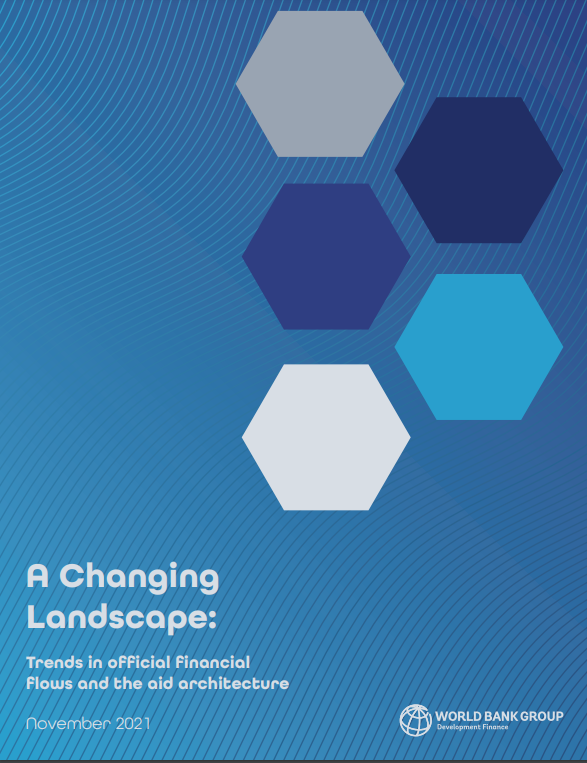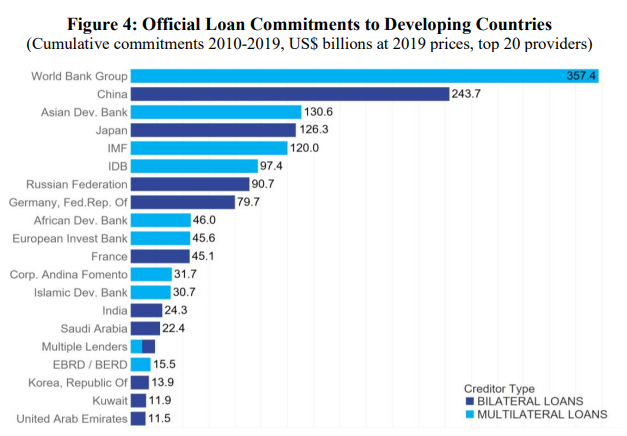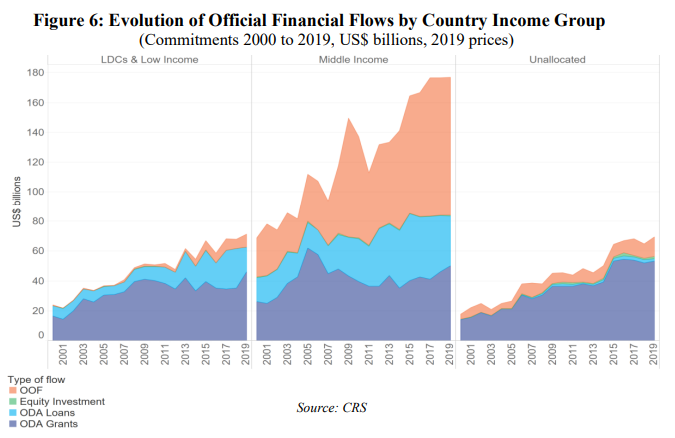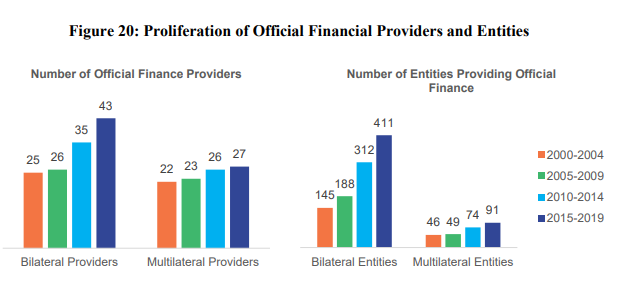The Changing Face of Aid

The World Bank just released a monster number crunch on the changing face of aid. ‘A Changing Landscape: Trends in official financial flows and the aid architecture’ covers ‘all private and public sector financing to developing countries’ up to the end of 2019 (aka the eve of the pandemic).
 Here are the main findings, with my attempts at a commentary + translation in italics:
Here are the main findings, with my attempts at a commentary + translation in italics:
Financial flows to developing countries have grown steadily over the last decade, largely thanks to private sector finance. During this period, private finance grew by 10 percent a year while official (i.e., public) finance grew by 2 percent a year. While in 2010 public finance represented 64 percent of total financial flows to developing countries, by 2019 public and private flows were almost equal.
Amazing that official aid grew at all, given the austerity going on in the rich countries. What’s happened to private flows under Covid? Nothing good, I imagine. Also, is it not possible to include remittances in the mix?
Among public lenders, BRICS countries provided significant volumes of loan financing. Over the last ten years, the BRICS provided 22 percent of loan financing globally. At the donor level, the World Bank Group and China were the two largest individual sources of loan financing. While the World Bank Group also provides a significant amount of grant financing, there is no data source which adequately covers grants provided by BRICS countries.

To a large extent, I assume, ‘BRICS’ = ‘China’. Impressively massive hole in the data on grants, but what I’ve read largely suggests BRICS prefer loans to grants anyway – more lend-scape than landscape.
Middle-Income Countries (MICs) received almost half of total ODA commitments since 2000 and 85 percent of Other Official Flows (OOF). Least Developed and Low-Income Countries (LDCs/LICs) received 94 percent of their financing as ODA. However, this amount only represented 30 percent of total ODA commitments over the period.
So much for aid’s poverty focus……
The volume of funding which donors have not identified as allocated to specific recipient countries almost quadrupled over the past two decades and now constitutes more than a fifth of official finance to developing countries. The rising share of resources not assigned to specific recipients indicates a growing focus on global and regional public goods and on support for emergencies (humanitarian aid and support to refugees in donor countries).
Interesting shift to global public goods, which I imagine is only going to increase via aspects of the climate crisis + Covid response.

Aid concessionality varied significantly across sectors, with grants deployed mostly for social sectors and support for emergencies, and concessional and non-concessional loans favored for infrastructure. More than two thirds of ODA grant commitments in the past five years were made in the social sectors and in support for emergencies. In contrast, 44 and 43 percent of ODA loans and OOF, respectively, were used for infrastructure investments.
So it’s grants for stuff like disasters, health and education, loans for bridges and roads. Makes sense.
There was a modest growth in the number of official finance providers since 2000, but a 2.5x growth in the number of entities providing official finance. Between 2000 and 2019, the number of official finance providers around the world grew from 47 to 70 while the number of entities providing official finance expanded from 191 to 502. The rapid increase in the latter may be due partly to the lack of full reporting at the beginning of the period.
Interesting, so yes, aid is getting increasingly fragmented, but not primarily because of new donor countries (Turkey, Saudis etc). The real problem is the proliferation of new agencies in existing donors.

Development activities remain highly fragmented; the average size of official finance activities has decreased by approximately one third in value in twenty years. Fragmentation appears to be mostly concentrated in social sectors and in bilateral activities. The impact on ODA grants, the dominant type of official flows, was particularly strong. The average size of an ODA grant decreased from US$1.5 million in 2000 to US$0.8 million today.
Typical aid grants have halved since 2020 (but there are a lot more of them, so aid continued to rise). Is that a problem? Yes if it means lots more form-filling, no if it means a wider range of recipients and smaller grants more attuned to local need. Discuss.
This first appeared on Duncan's From Poverty to Power blog and was reposted with permission.
Image: Mark Morgan via Flickr (CC BY 2.0)


